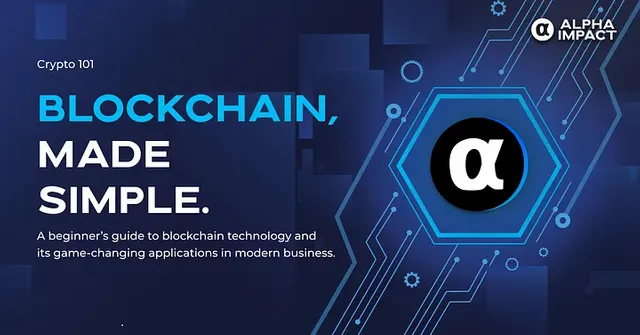Blockchain 101: The Technology Reshaping Our Digital World | Alpha Impact

Blockchain has emerged as a cornerstone of digital innovation, moving far beyond its cryptocurrency origins. This distributed ledger technology has found its way into finance, healthcare, and supply chain management, capable of transforming and reshaping whole industries. In this article, we take a deep dive into what blockchain technology is, how it works, its types like permissioned blockchains, and the latest innovations in the blockchain space.
What is Blockchain?

Think of blockchain as a digital ledger shared across multiple computers. Instead of keeping records in one place, it spreads encrypted transactions across a network, making the data transparent, immutable, and secure. This makes it ideal for purposes and applications requiring trust and autonomy.
The name “blockchain” is a combination of two words-block and chain-two core components of the blockchain structure:
Blocks: Digital containers holding transaction records
Chain: Connections linking each block together, forming a continuous, tamper-resistant chain.
Unlike traditional networks and systems that are often controlled by a central authority, blockchain operates in a decentralised manner, i.e. all the nodes in the network share and verify the ledger and combinedly manage the network.
How Blockchain Technology Works
Blockchain facilitates peer-to-peer transactions without middlemen or third parties.
- Transaction Initiation: When a user initiates a transaction, it gets encrypted and sent to the network for processing.
- Validation: Network participants (miners or validators) check its validity using a relevant consensus mechanism like Proof of Work (PoW) or Proof of Stake (PoS).
- Block Creation: Once verified, the transaction is added to the current block.
- Consensus: This new block joins the chain permanently, in a way where it links to the previous and future blocks.
- Immutability: The block is now tamper-proof, as changing any information would require altering every subsequent block — a nearly impossible task!
This decentralised, cryptographic method of recording transactions ensures high security, transparency and immutability in a blockchain network.
Real World Applications
Thanks to its versatility, blockchain has use cases across numerous industries, such as:
- Finance: The development of secure, fast, and cost-effective cross-border transactions — the backbone to many decentralised financial (DeFi) ecosystems.
- Healthcare: Medical teams can now access unified records globally, with enhanced privacy and more efficient patient treatment.
- Supply Chain Tracking: Companies can track goods in real-time from source to delivery, ensuring authenticity and transparency at every step.
- Voting: Transparent and tamper-proof voting systems for both corporate and civic engagement.
- Trading: Peer-to-peer trading of worldwide assets, from commodities and stocks to digital currencies.
Understanding Blockchain Types
The two major types of blockchains are Permissioned and Permissionless. While permissionless blockchains, also called public blockchains, like Bitcoin and Ethereum are open to anyone, permissioned blockchains are kind of private and offer restricted access based on permissions.
Permissionless Blockchains
The cornerstone of many cryptocurrency systems, permissionless blockchains are open for anyone to join and participate.
- Examples: Bitcoin, Ethereum
- Focus on transparency and decentralisation
- Ideal for public applications and cryptocurrencies
Permissioned Blockchains
Unlike its counterpart, permissioned blockchains offer a balance between open decentralisation, allowing organisations to restrict access for enhanced security and privacy.
- Examples: Hyperledger, Corda
- Focuses more on efficiency, scalability, and privacy
- Ideal for enterprise supply chains, banking, and healthcare systems
The Journey so Far
Blockchain has evolved significantly since its debut with Bitcoin in 2009.
- Blockchain 1.0 (Cryptocurrency): The first blockchain introduced the concept of secure, peer-to-peer transactions of digital assets without intermediaries.
- Blockchain 2.0 (Smart Contracts): The next version of the blockchain, launched with Ethereum, introduced smart contracts-programmable entities enabling automation and decentralised applications (DApps).
- Blockchain 3.0 (Interoperability and Scalability): The emergence of projects, such as Polkadot and Cosmos, was created to solve scalability issues in existing systems and enable cross-communication between different blockchains.
- Blockchain 4.0 (Enterprise Solutions): Current developments merge blockchain with AI, IoT, and Big Data to offer higher efficiency and functionality for businesses.
Alpha Impact demonstrates practical blockchain use through its copy trading platform. By incorporating on-chain wallets for Ethereum and Polygon networks, the platform creates a secure environment for trading digital assets and copying expert strategies.
Users can easily purchase digital assets and swap them for FOLO , the platform’s native cryptocurrency powering the Alpha Impact ecosystem.
Conclusion
The future of blockchain technology is bright with possibilities. We continue to see blockchain open doors across industries, from financial institutions building accessible services, to novel platforms like Alpha Impact who make digital asset trading more intuitive.
As adoption grows, we’re likely to see an emergence of user-friendly applications, improved integration within existing systems, and even more innovative financial products and services.